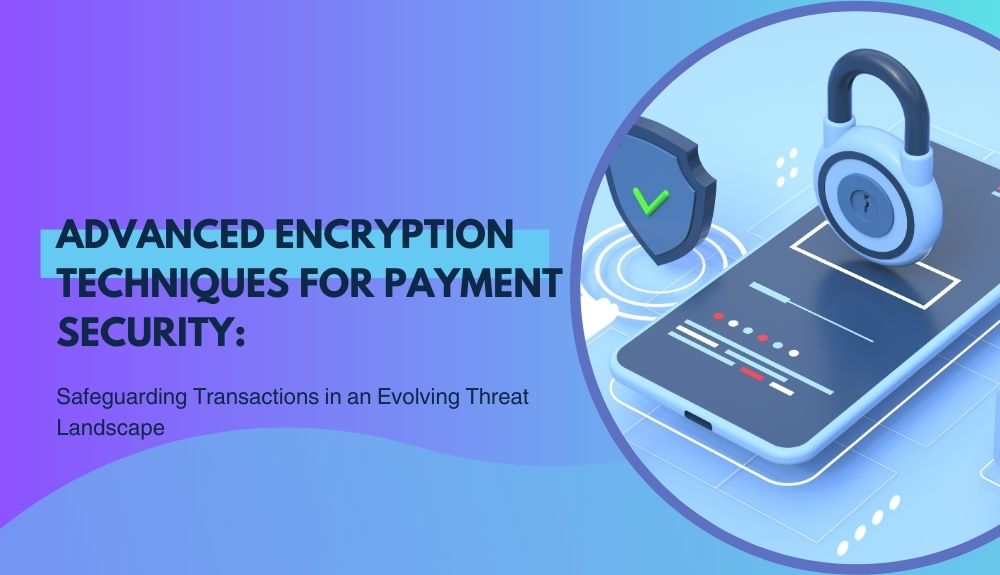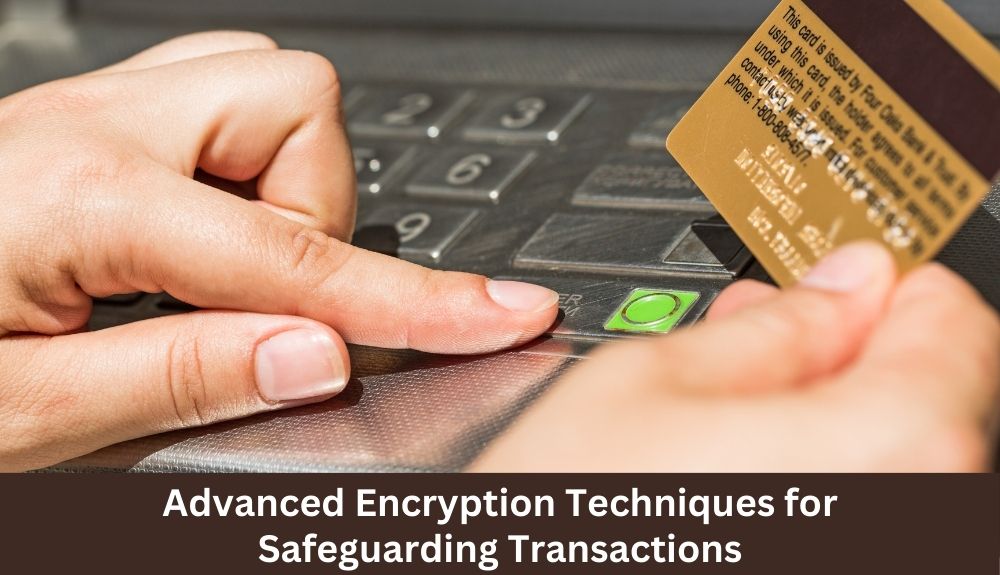
By max February 15, 2024
Introduction to Payment Security
In today’s digital world, where transactions are increasingly being conducted online and through mobile devices, payment security has become of utmost importance. With cyber threats constantly evolving and becoming more sophisticated, safeguarding sensitive financial information has become a top priority for businesses and consumers alike.
Gone are the days when simply entering credit card details on a website was enough to make a purchase. Now, it is crucial for organizations to implement advanced encryption techniques and employ cutting-edge technologies to ensure that transactions are protected from potential breaches.
In this blog post, we will explore the ever-changing landscape of payment security and delve into some advanced encryption techniques that can help safeguard your valuable transactions. From tokenization to biometric authentication and the impact of artificial intelligence, we’ll cover it all. So buckle up as we dive into the fascinating world of payment security in an evolving threat landscape!
The Evolution of Payment Security Threats
Payment security has always been a top priority for businesses and consumers alike. As technology advances, so do the threats that target payment systems. In today’s evolving threat landscape, it is crucial to stay ahead of the curve and implement advanced encryption techniques to safeguard transactions.
In the past, payment security threats primarily revolved around physical theft or fraud. However, with the rise of e-commerce and digital payments, cybercriminals have found new ways to exploit vulnerabilities in online transactions.
One of the major advancements in payment security is the use of encryption techniques. Encryption ensures that sensitive data transmitted between parties is unreadable to anyone except authorized individuals. Advanced encryption algorithms such as AES (Advanced Encryption Standard) provide robust protection against unauthorized access and data breaches.
Another important aspect of payment security is tokenization. Tokenization replaces sensitive information like credit card numbers with unique identification symbols or tokens. These tokens are meaningless to hackers even if they manage to intercept them during transmission or storage.
Biometric authentication has emerged as a game changer in payment security. By using unique biological traits such as fingerprints or facial recognition, biometric authentication adds an extra layer of protection by ensuring that only authorized users can initiate transactions.
Artificial intelligence (AI) has also had a significant impact on improving payment security measures. AI-powered algorithms can detect suspicious patterns and behaviors in real-time, helping identify potential fraudulent activities before they cause any harm.
The evolution of payment security threats necessitates constant vigilance and adaptation from businesses and individuals alike. Implementing advanced encryption techniques like AES along with tokenization and biometric authentication can significantly enhance transactional safety in today’s digitally-driven world.
By staying up-to-date with emerging technologies such as AI, businesses can proactively address potential vulnerabilities before they become exploited by cybercriminals.
Advanced Encryption Techniques for Safeguarding Transactions

In today’s digital world, safeguarding payment transactions is of utmost importance. With the constant evolution of cyber threats, it has become imperative for businesses to adopt advanced encryption techniques to protect sensitive customer data and ensure secure transactions.
One such technique is end-to-end encryption (E2EE), which ensures that data remains encrypted throughout the entire transaction process. This means that even if hackers manage to intercept the data, they won’t be able to decipher it without the proper decryption keys.
Another effective encryption technique is multi-factor authentication (MFA). By using a combination of something you know (like a password or PIN), something you have (like a smartphone or token device), and something you are (like biometric information), MFA adds an extra layer of security to verify user identity before allowing access to sensitive payment information.
Additionally, there is also homomorphic encryption, which allows computations on encrypted data without having to decrypt it first. This enables businesses to perform complex calculations on encrypted financial data while keeping it fully protected from unauthorized access.
Furthermore, quantum-resistant algorithms are being developed as a response to the threat posed by quantum computers in breaking traditional cryptographic systems. These algorithms use mathematical structures that are resistant against attacks from both classical and quantum computers.
As technology advances, so do the methods used by cybercriminals. Therefore, staying ahead in this ever-changing landscape of payment security requires continuous innovation and implementation of advanced encryption techniques. It’s crucial for businesses to partner with experts in cybersecurity who can provide them with cutting-edge solutions tailored specifically for their needs.
By leveraging these advanced encryption techniques, businesses can instill trust among their customers and mitigate potential risks associated with payment transactions. After all, when it comes to securing sensitive financial information, there’s no room for compromise!
Tokenization and its Role in Payment Security
Tokenization is a powerful technique that plays a critical role in enhancing payment security. By replacing sensitive cardholder data with unique tokens, tokenization eliminates the risk of exposing valuable information during transactions. How does it work? When a customer makes a purchase, their credit card details are securely stored in a token vault and replaced with an unrelated string of characters called tokens. These tokens can then be used for future transactions without compromising the original payment information.
The beauty of tokenization lies in its ability to render stolen or intercepted data useless to cybercriminals. Even if they manage to get hold of the tokens, they won’t have access to any meaningful information that could be used for fraudulent purposes. This significantly reduces the chances of successful attacks and provides customers with peace of mind when making online purchases.
In addition to secure storage, tokenization also offers benefits such as simplified compliance with industry regulations like PCI-DSS (Payment Card Industry Data Security Standard). By removing sensitive data from merchants’ systems, businesses can reduce their scope for compliance audits and minimize potential liabilities.
Furthermore, tokenization enhances convenience by enabling recurring payments without storing actual credit card details on file. This is particularly useful for subscription-based services or e-commerce platforms where repetitive billing occurs regularly.
Tokenization serves as an effective layer of protection against payment fraud in today’s digital landscape. Its ability to replace sensitive data with meaningless tokens ensures that even if attackers breach systems or intercept communication channels, they will find no usable information. As technology continues to evolve and threats become more sophisticated, implementing advanced techniques like tokenization becomes increasingly crucial for safeguarding transactions and maintaining trust among consumers.
Biometric Authentication: A Game Changer in Payment Security
When it comes to payment security, traditional methods like passwords and PINs are no longer enough. Hackers have become increasingly adept at cracking these codes, leaving consumers vulnerable to fraud. That’s where biometric authentication steps in as a game changer.
Biometric authentication uses unique biological characteristics such as fingerprints, voice patterns, or even iris scans to verify a person’s identity. Unlike passwords that can be easily forgotten or stolen, biometrics are nearly impossible to replicate.
One of the key advantages of biometric authentication is its convenience. Gone are the days of typing out long and complex passwords; now all you need is your fingerprint or face recognition technology on your smartphone or other devices.
Moreover, this technology provides an extra layer of security by making it extremely difficult for cybercriminals to impersonate someone. After all, how can they fake your fingerprint?
But what about privacy concerns? Companies implementing biometric systems must adhere to strict regulations regarding data protection and ensure that user information remains confidential.
As we move towards a more connected world with the Internet of Things (IoT) becoming pervasive in our daily lives, biometric authentication will play a crucial role in securing transactions across multiple platforms seamlessly.
Biometric authentication represents a significant leap forward in payment security. Its ability to provide robust protection while offering convenience makes it an invaluable tool for safeguarding transactions in today’s evolving threat landscape.
Impact of Artificial Intelligence on Payment Security

Artificial Intelligence (AI) has emerged as a powerful tool in the field of payment security, revolutionizing the way transactions are protected against evolving threats. With its ability to analyze vast amounts of data and identify patterns that humans may miss, AI brings a new level of sophistication to safeguarding sensitive financial information.
One key area where AI is making an impact is fraud detection. Traditional rule-based systems can be limited in their ability to detect new or emerging forms of fraud. AI-powered algorithms, on the other hand, can continuously learn from past transactions and adapt to changing patterns of fraudulent activity. This enables faster identification and prevention of fraudulent transactions, reducing losses for both businesses and consumers.
Another aspect where AI shines in payment security is anomaly detection. By analyzing massive volumes of transactional data in real-time, AI algorithms can quickly flag any unusual or suspicious behavior that deviates from normal patterns. This helps identify potential instances of unauthorized access or account takeover attempts before they cause significant damage.
Moreover, AI plays a crucial role in enhancing customer authentication processes for secure payments. Biometric technologies such as facial recognition and fingerprint scanning leverage AI algorithms to verify the identity of individuals with high accuracy. This not only provides convenience for users but also adds an extra layer of protection against identity theft or impersonation.
Furthermore, machine learning techniques employed by AI systems enable continuous improvement in threat detection capabilities over time. As new types of cyber threats emerge, AI models can adapt and evolve accordingly by incorporating knowledge gained from previous encounters with similar attacks.
Artificial intelligence has transformed payment security by enabling more effective fraud detection, anomaly identification, enhanced customer authentication methods like biometrics while continuously evolving to combat emerging threats effectively
Conclusion: Staying Ahead in the Ever-Changing Landscape of Payment Security
As we have explored in this article, payment security is an ever-evolving landscape that requires constant vigilance and proactive measures to stay one step ahead of cyber threats. With the increasing sophistication of hackers and their methods, it is crucial for businesses to employ advanced encryption techniques to safeguard transactions.
By implementing strong encryption algorithms, such as AES-256 and RSA, businesses can ensure that sensitive payment data remains secure during transmission and storage. Additionally, tokenization provides an extra layer of protection by replacing cardholder information with unique tokens, further minimizing the risk of data breaches.
Biometric authentication has emerged as a game changer in payment security. By leveraging biometric traits such as fingerprints or facial recognition, businesses can enhance user verification processes and reduce reliance on easily compromised passwords or PINs.
Furthermore, artificial intelligence plays a vital role in strengthening payment security by continuously analyzing vast amounts of data for patterns and anomalies. AI-powered systems can detect suspicious activities in real-time and alert users or administrators to potential threats.
In this rapidly evolving threat landscape, staying ahead requires ongoing investment in technology upgrades, employee training programs, and collaboration with industry experts. It is essential for organizations to prioritize payment security by adopting state-of-the-art encryption techniques and keeping abreast of emerging trends.
Remember that no solution is foolproof when it comes to cybersecurity; therefore regular audits should be conducted along with continuous monitoring efforts. By taking a proactive approach towards payment security measures today, businesses can minimize vulnerabilities tomorrow.
With technological advancements bringing new challenges every day, safeguarding transactions will always remain paramount for both consumers and businesses alike. By embracing advanced encryption techniques alongside tokenization strategies while incorporating biometric authentication methods into existing systems – all powered by cutting-edge artificial intelligence – we pave the way towards a more secure future where payments are protected from even the most sophisticated threats.
